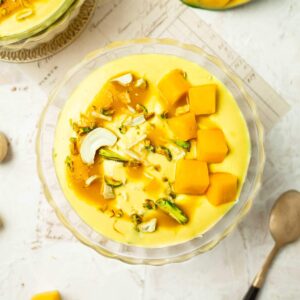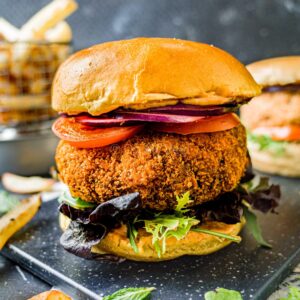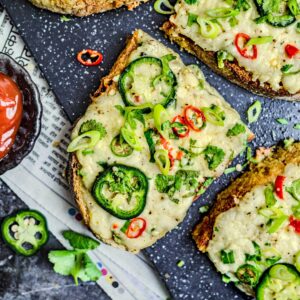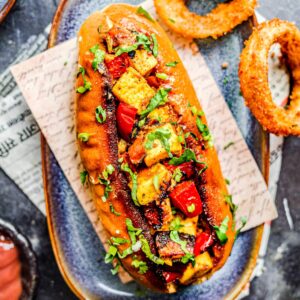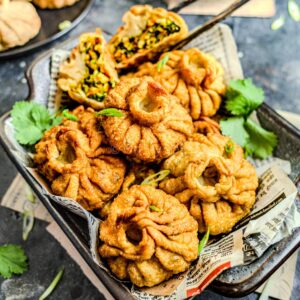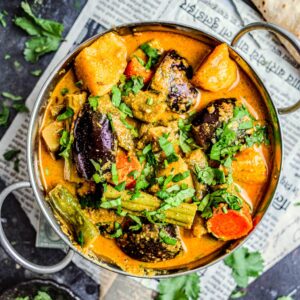Chitranna, South Indian Lemon Rice
Chitranna: Fluffy, long, and separated grains of rice are gently tossed with a piquant tempering featuring crunchy lentils, roasted nuts, citrusy curry leaves, peppery mustard, golden turmeric, and an ample squeeze of fresh and zesty lemon juice. Sprinkle with freshly chopped coriander (cilantro), and all that’s left to do is tuck in … before you know it, the plates of lemon rice will be polished off!
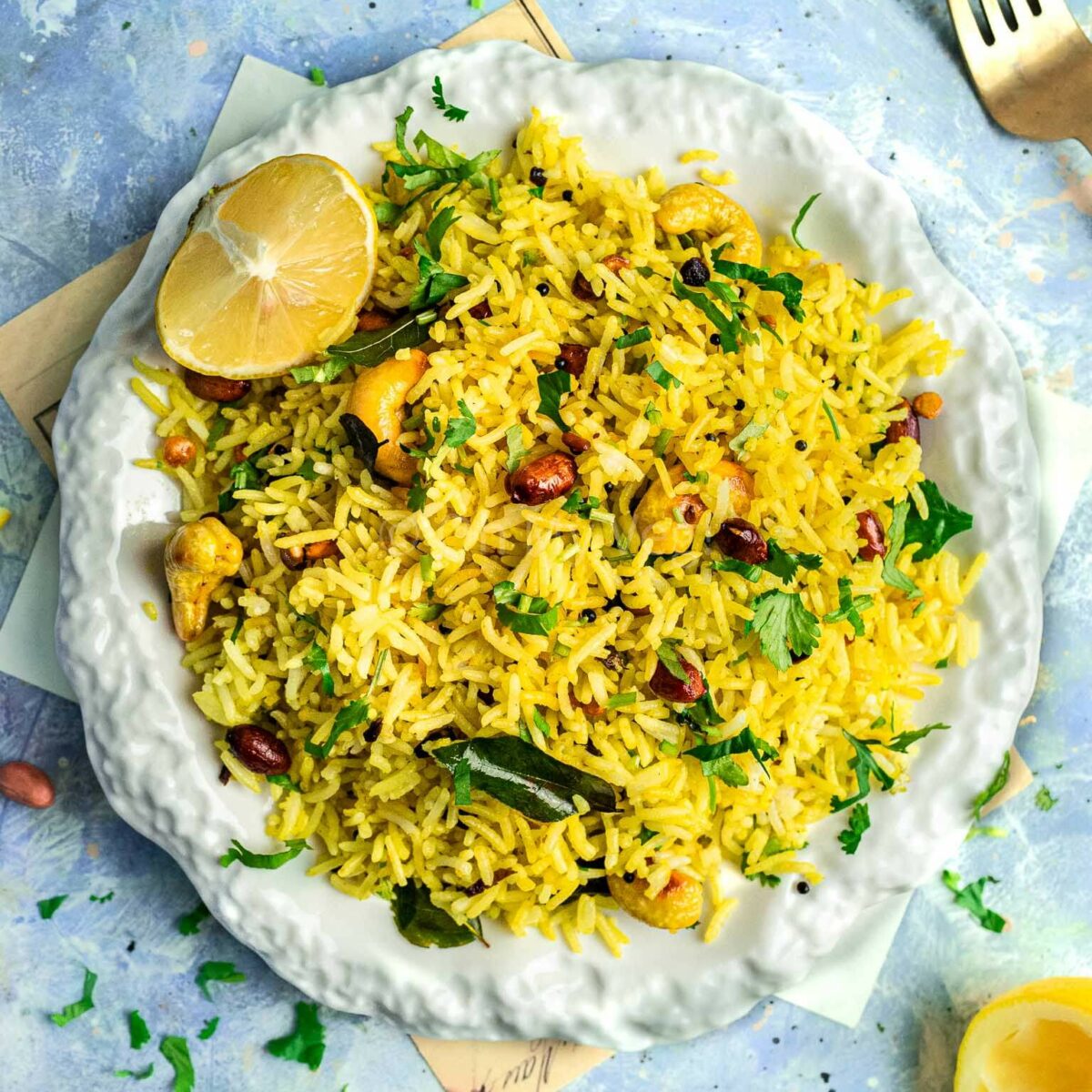
Now, I love biryani as much as the next person (especially paneer biryani!), but when the summer heat hits, I start craving lighter, fresher dishes. South Indian lemon rice (known as “chitranna” in Kannada) fits this brief to a tee.
Lemon rice originates from the South Indian state of Karnataka and is famous for other dishes like curd rice, bisi bele bath, Mysore masala dosa, and vada with sambar. The zesty rice dish is enjoyed as a lunchtime staple, especially in summer. You’ll find thousands of people savouring the rice dish in work or school tiffins, during picnics, or even while travelling.
It’s one of my go-to dishes when searching for a quick and easy dish — along with other favourites from my useful 30-minute or less recipe collection.
This recipe will teach you how to make chitranna the traditional way — which is also surprisingly uncomplicated. Ready to find out how?
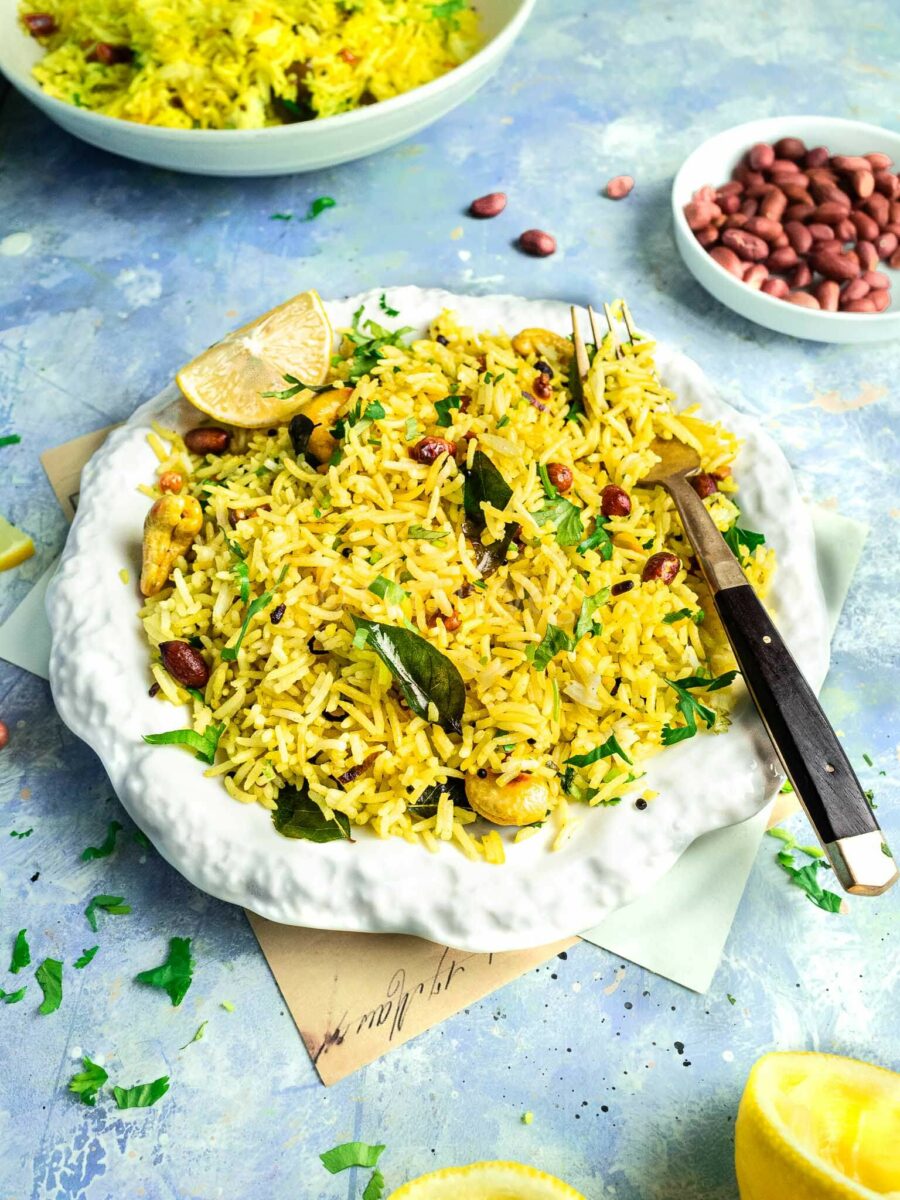
Ingredients for Chitranna
If you cook Indian food regularly, your cupboards are likely already stocked with all the basic pulses, essential spices, nuts, herbs, and rice you need for this chitranna! However, if not, no worries.
All of these ingredients are easy to source at your local Asian store, or via my Amazon storefront. You can use the list below as a shopping list, and check out the full quantities in the recipe card below.
- Rice is, of course, one of the most important components of the dish. My first preference is ultra-long grain basmati. Its characteristic features, such as fragrance and fluffy grains, are ideal. However, I’ve also had great success with sona masoori rice.
- Oil is needed for tempering the lentils, nuts, and spices. Traditionally, you’ll want to use gingelly oil (raw sesame oil).
- Black mustard seeds are spicy, hot, and peppery. Don’t substitute for white mustard.
- Chana dal is an essential part of South Indian tadka (tempering). It’s nutty and earthy, but also adds delicious crisp pieces to the recipe!
- Split urad dal provides explosions of mild, creamy, and nutty flavour in every bite.
- Curry leaves build on citrusy flavours. Use fresh.
- Nuts (specifically cashews and peanuts) are optional, but I highly recommend adding them for the textural crunch.
- Lemon juice is a fundamental part of lemon rice! Furthermore, the best results are from using freshly squeezed lemon juice; it prevents the dish from becoming bitter.
- Green chilis add heat to the chitranna. If you’re making the dish for children or those with a low spice tolerance, cut down on the chilis or skip entirely. Green chilis also add sharpness, and a surprising touch of fruity, floral notes.
- Turmeric powder in moderation gives a beautiful golden colour and earthy, peppery nuance.
- Salt is a must. Season your food, always!
- Fresh coriander (cilantro, for U.S. readers) is the perfect finishing touch, with citrusy overtones.
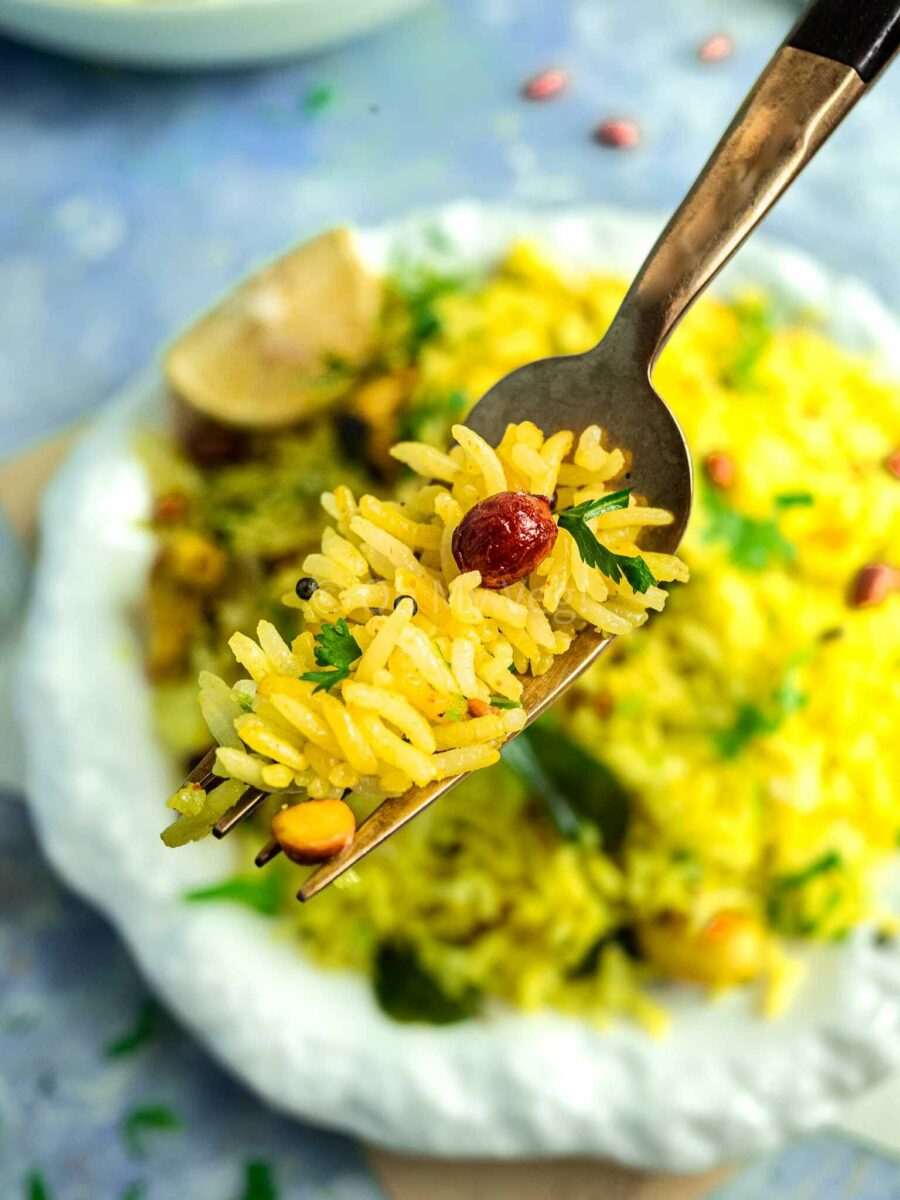
Ingredient Substitutions, Swaps, and Lemon Rice Variations
If you don’t have some ingredients to hand, don’t worry! You can make some substitutions without affecting the integrity of flavours. Here’s some trouble-free swaps:
Furthermore, although standard chitranna is almost unbeatable, it’s fun to shake things up sometimes! In Karnataka — the birthplace of lemon rice — there are a handful of traditional variations you may want to give a whirl:
- Add onions to make a traditional variation called eerulli chitranna.
- Go rogue and add finely chopped spinach for an ultra-healthy lunch option.
- Use lime juice instead of lemon for an intense tart, slightly bitter flavour.
- Grate raw mangoes into the tempering to make mavinakayi chitranna. It has a sour, citrusy, and slightly sweet flavour ideal for summer.
Lemon Rice Allergens
You know I love to share recipes suitable across a wide range of dietary needs and preferences — and this lemon rice is 100% one of those recipes!
South Indian chitranna is naturally vegan, gluten-free, soy-free, and alcohol-free. Plus, it’s suitable for halal and kosher diets. And even better, because this is a no-garlic and onion chitranna recipe, it’s also acceptable for Jains.
However, lemon rice is not nut-free. Peanuts are a traditional component, and I love the added crunch of roasted cashews. There’s nothing to say the recipe can’t be adapted, though. To make lemon rice nut-free, consider adding roasted chickpeas, makhana, or sunflower seeds to the rice instead — it will be nutritious and delicious!
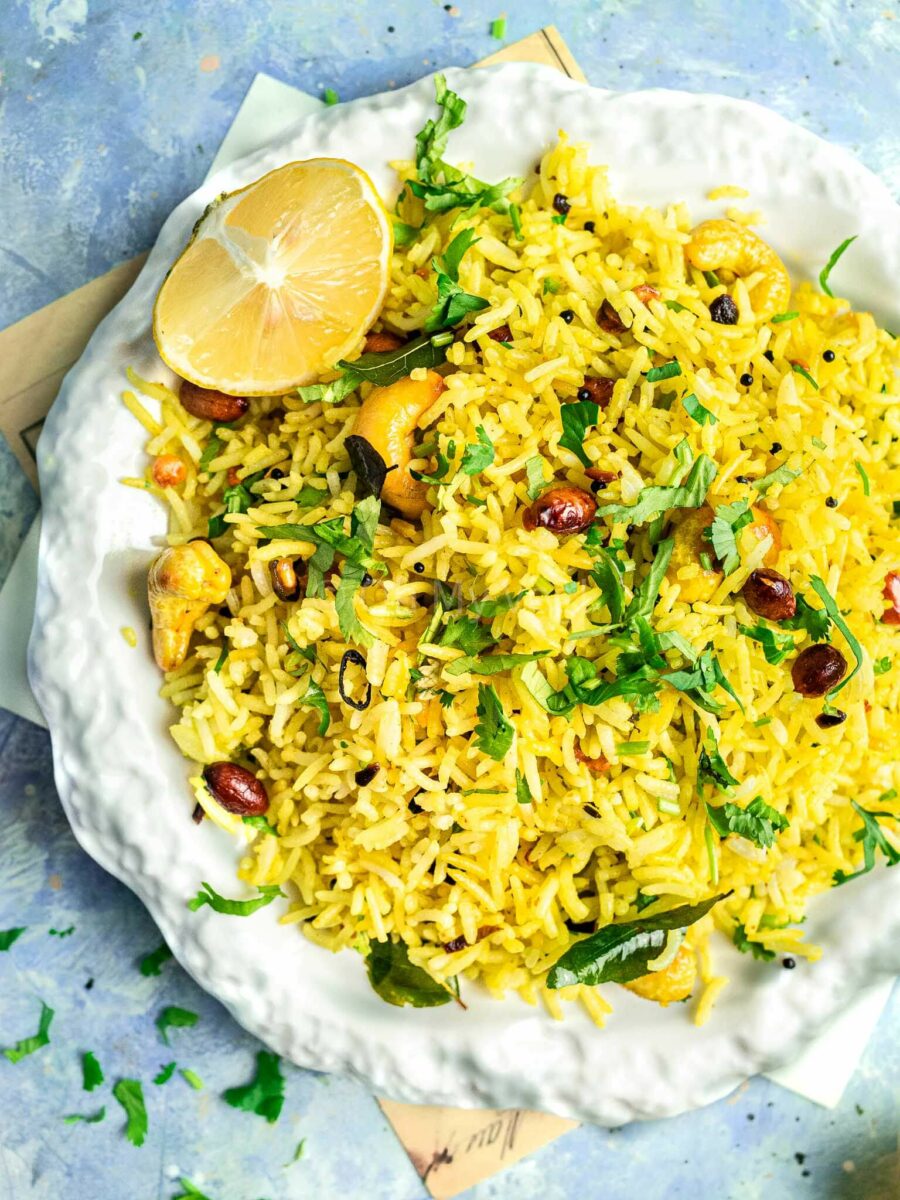
How to Make Lemon Rice
My favourite thing about this chitranna recipe, you ask? Aside from the bright and refreshing flavour, it’s undoubtedly how straightforward the cooking process is! In fact, how to prepare chitranna can be broken down into just four fuss-free steps:
- Wash the rice and then put it to cook.
- Temper the lentils, curry leaves, nuts, green chilis, and turmeric in oil.
- Pour the tempering over the rice.
- Add lemon juice, salt, and freshly chopped coriander to the rice. Mix well.
Expert Tips for the Best Chitranna
Lemon rice might seem like an incredibly effortless recipe to cook. And once you have the expert knowledge, that’s correct. But, if you’re unpracticed in cooking rice — the Asian way — then I recommend you follow this advice for non-sticky, fluffy, separate grains … every single time.
- Wash your rice! This is the SINGLE most vital piece of advice I can give you. I know, I know. Washing rice is a pain, and skipping this stage is so tempting. But it’s worth it, I promise! Rinse the rice in cold water, several times, or until the water runs clear.
- Add enough water to reach your first knuckle. I don’t give exact water measurements in this recipe. Why? Because different brands of basmati rice (not even accounting for other rice varieties!) absorb water differently. But it’s always a good rule of thumb (haha) to measure the water by touching the rice with your finger and allowing the water to reach your first knuckle.
- Salt the water while the rice is cooking. It’s the same theory as pasta; it makes tastier rice.
- Fluff with a fork after cooking for enviable fluffy grains.
- You can soak the lentils ahead of time to make them softer.
- Be careful not to burn the spices when making the tadka (tempering). Cook over low heat if you’re not confident.
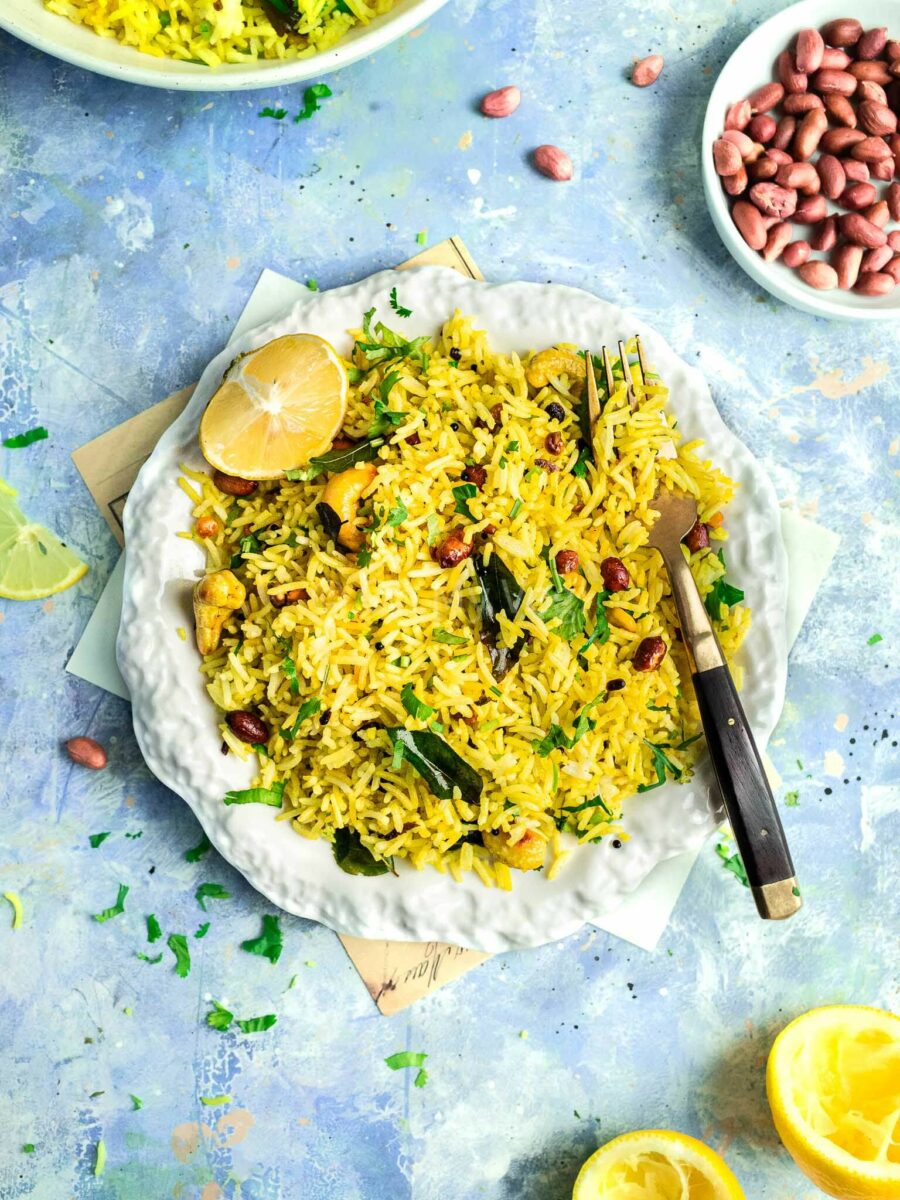
What is Lemon Rice Eaten With?
Although it can be eaten hot, lemon rice is best enjoyed cold or at room temperature, allowing the flavours to meld together and shine through. Because of this, I prefer to serve chitranna with simple condiments or vegetable side dishes that taste great cold. Here are some of my favourites:
- Lemon rice and curd is the most widespread pairing. The cool curd — a type of thick Indian yoghurt, often homemade — matches the citrusy, spicy rice. Even though plain yoghurt is the standard, a simple raita wouldn’t go amiss either.
- Chitranna with a pickle (achaar or uppinakāyi) is a personal favourite. Raw mango or lemon pickles are obvious choices, as they impart an extra boost of tanginess.
- Serve roasted papad (poppadum or vadam) with lemon rice for a nutty crunch. This is a must with either of the above options!
- Lemon rice and potato fry is a classic lunchtime combo. The simply spiced stir-fried potatoes taste fantastic with most South Indian rice recipes, including curd rice.
- Chitranna and green beans palya are ideal for a light springtime meal. Palya is similar to the Tamil poriyal, whereby the beans are finely chopped, and then satuéed with coconut and spices.
This Recipe Is:
Lemon Rice, South Indian Chitranna

South Indian lemon rice, called Chitranna, is fluffy rice mixed with zesty lemon juice, fresh herbs, and a spicy, crunchy tempering.
Ingredients
- 200g Basmati or Sona Masoori Rice
- Sea Salt, to taste
- 1 tbsp Gingelly Oil
- 1/2 tsp Black Mustard Seeds
- 1.5 tsp Chana Dal
- 1/2 tsp Split Urad Dal
- Sprig Curry Leaves (18)
- 2 tbsp Peanuts
- 10 Cashews
- 3 Green Chilis, finely sliced
- 1/4 tsp Turmeric
- 2 tbsp Lemon Juice (1 Lemon)
- Fresh Coriander (Cilantro), to serve, optional
Instructions
- Cook the rice*. Begin by washing it until the rice runs clear, then add it to a pan. Add enough water so that when you touch the rice with a finger, the water comes level with your first knuckle. Salt the water and cook on low heat until the water is absorbed and the rice is soft. Fluff with a fork and wait to cool**.
- Make the tempering. Heat a small tadka pan over medium flame. Add gingelly oil. Once the oil is heated, add the mustard seeds until they pop. Quickly add the chana and urad dal, curry leaves, peanuts, cashews, and green chilis. Once they lentils are nuts turn golden, and turmeric, mix, and switch off the heat.
- Mix the rice. Add the tempering, fresh lemon juice, and chopped coriander to the cool rice. Mix well.
Notes
* You can skip this step entirely and use leftover rice.
** To quickly cool rice, spread it on a baking tray and leave exposed to the air or place it in the refrigerator.
Recommended Products
As an Amazon Associate and member of other affiliate programs, I earn from qualifying purchases.
Nutrition Information:
Yield:
4Serving Size:
1Amount Per Serving: Calories: 216Total Fat: 8gSaturated Fat: 1gTrans Fat: 0gUnsaturated Fat: 6gCholesterol: 0mgSodium: 199mgCarbohydrates: 32gFiber: 2gSugar: 2gProtein: 5g
Nutrition information isn’t always accurate.







